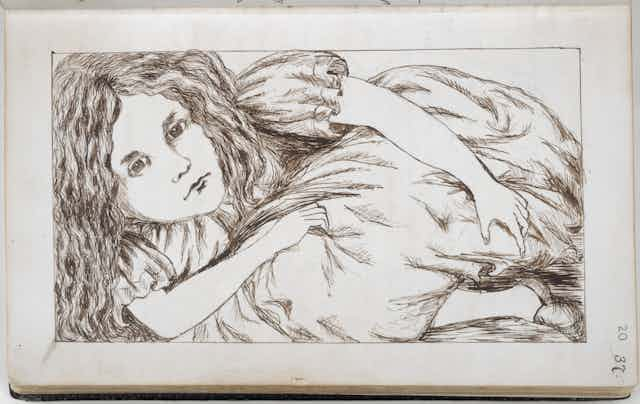In the past 150 years Lewis Carroll’s Alice has undergone innumerable transformations. Instantly popular, she quickly escaped her original novelistic environment, appearing in Victorian Punch caricatures, on magic lantern slides and on stage. Only five years after Carroll’s death, Alice in Wonderland had already been made into a short silent film.
Ever since, her pioneering success in multimedia has continued: Alice escapes the whirl of Disney’s colourful and sugar-coated animated Wonderland (1951), navigates Jonathan Miller’s mesmerising monochrome Alice (1966), and even conquers Jan Švankmajer’s stop-motion surrealist experiment (1988). In the spirit of the original dizzying dream-venture, Alice is always trailblazing through new and uncharted territory, always embracing new possibilities, her adventures always somewhat unsettling.
This sentiment has also characterised her ventures into the dawn of the 21st century, conquering cyberspace in a set of video games by the master of the digital Gothic fairy-tale, American McGee. These games strike a distinctly darker note: set after the death of Alice Liddell’s family in a house fire, the now teenaged Alice lives in a Victorian London asylum.

Here, in the hands of a mesmerist-come-psychiatrist, she struggles to regain memory of the incident. Navigating her post-traumatic hallucinatory spells in wonderland, Alice fuses past and present. Players embark on a journey to recover fragments of her lost memories in an upset psychological dreamscape, which disintegrates the deeper they penetrate into Alice’s mind.
Alice Reloaded
McGee’s and Carroll’s stories might at first seem unlike, but one can teach us a lot about the other. Whether configured as dream or visions of madness, Alice’s imaginations react, in fantastical manner, to actual historical realities.
Carroll’s Alice is a story written by an Oxford don for the dean’s daughter. In her dream this Victorian girl gains the agency to question the power dynamics of her environment. Her vision turns popular Victorian morality poems and the etiquette of the tea-party into “uncommon nonsense”, questioning the genuineness of their underlying morality.
McGee latches on to this subversive potential. Industrial corruption is a major theme of the game, for instance. His Hatter and Hare turn into steampunk horror owners of a tea factory, enslaving and mechanically enhancing wonderland creatures. Industry appears as a new religion overriding the individual, visually embodied in a gigantic polluting train shaped like a Gothic cathedral – a take on Victorian history that hits home even almost two centuries after the Victorians. The player helps Alice to uncover these atrocities.

Further adventures
Many modern scholars have acknowledged the significance of Carroll’s classic as a watershed moment in the history of children’s literature. Carroll’s heroine, unlike those of other dream-journeys, does not progress by obeying moral agendas. She actively questions the static doctrines of the parodied adult figures of Wonderland, acting according to her own will.
In doing so, Alice puts a magnifying glass to reality, enlarging fragments of it to terrifying dimensions. She becomes a subversive interpreter of the world, a conqueror ascending to a position to dismiss a Royal court as “nothing but a pack of cards”. It is this core element of Alice’s appeal to modern audiences that McGee has focused on in his games.
McGee understands Alice as someone who has conquered both the physical and the mindspace. Envisaged as a trilogy from the start, he takes the notion of Alice as a explorer of psychology further in his most recent instalment, a series of short films rather than a game. In Alice: Otherlands (2015) Alice hops from her mind into others, peering into the creative genius that drove the 19th century. In films of diverse styles she explores the minds of scientist Edison, of painter Vincent van Gogh, composer Richard Wagner, or of science fiction writer Jules Verne, and accompanies them on their extraordinary journeys of artistic invention. Alice, once again becomes our guide and interpreter, this time to the process of transforming reality into vision, into art, itself.
Underground icon and pioneer
Often criticised for the dark tone of his adaptation, McGee confidently explained to me in an interview that he never “decided” that Alice should become a “gothy” character. Instead, he believes, “we were all aware of it, subconsciously”, noting “she was already a captain, an icon of that feeling” of “underground culture”. She literally and figuratively navigates what Donald Rackin has called “the comic horror-vision of the chaotic land beneath the man-made groundwork of Western thought and convention.”
Alice is always somehow “us”, but not “them”. She acts as a mediator. McGee is on side with Carroll creating an empowered heroine, a “beautiful, powerful, and interesting person” – appealing to us aesthetically and intellectually. We were always somehow part of what was inherently conceived as an interactive story. It was, after all, the reader who had to turn the page to make Tenniel’s illustration of the Cheshire Cat disappear.

Perhaps one of the reasons Alice remains so successful is the timelessly powerful narrative pattern of making sense of the world through the eyes of a questioning outsider. And in this vein, McGee, like many before him, follows Carroll’s footsteps endowing the “reader” of his tale with agency.
In a century in which interactive digital media offers novel ways of drawing in the “reader”, we not only discover with Alice, we can become Alice, and discover yet unknown realities underlying our own lands that make us wonder. So here’s to the next 150 years of Alice.

